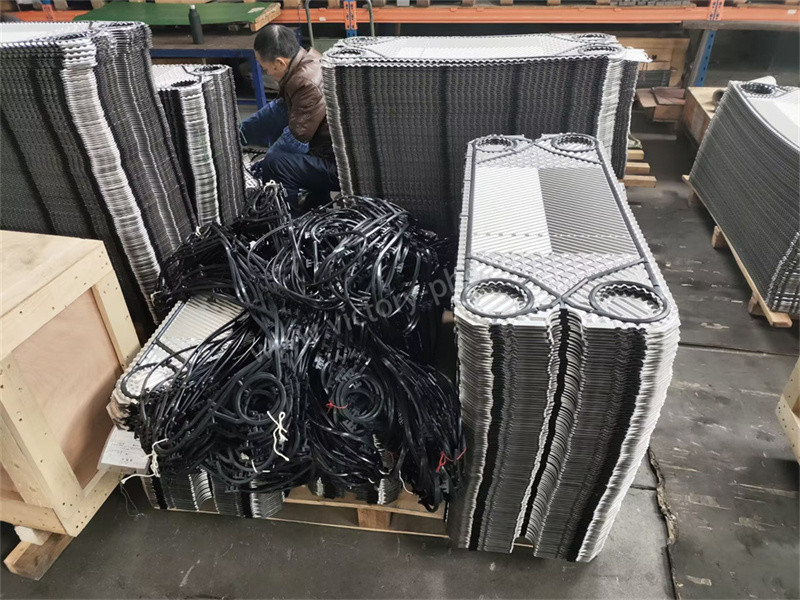Changzhou Victory Technology Co., LTD |
|
Verified Suppliers
|
|
Product Description
Heat Exchanger Gasket/Pad for Sondex Plate Heat Exchangers:
1.Heat exchanger gaskets, also known as O-rings, are small-sized components that are highly effective in sealing applications. They can be utilized for both static and dynamic sealing purposes.
2.Made from soft rubber materials, these gaskets have the ability to deform and store energy when compressed. This deformation generates contact pressure, effectively blocking any potential leakage paths and ensuring a reliable seal.
3.In the context of plate heat exchangers, the sealing gasket assumes a critical role in maintaining the overall integrity and performance of the heat transfer equipment. It directly influences the operational temperature limits and pressure capacity of the heat exchanger.
4.The primary function of the gasket is to establish a secure seal, preventing any undesired leakage of the heat transfer medium into the surrounding environment. Furthermore, it serves to prevent cross-contamination between different materials being processed within the heat exchanger.
| Brand/Maker | Model |
| Sondex | S1,S4,S4A,S7A,S8,S8A,S9A,S14,S14A,S17,S19A,S20A,S21A, S22A,S31A,S22,SW26,S37,SW40A,S41,S41A,S42,S42A,S62, S43,S47,SN51,S52,S64,S65,S81,S100,S121,SF123,SF160 |
Gasket Material:
| Material | Operating Temperature Range | Usage conditions |
| Nitrile Gaskets | ≤135℃ | Resistant to mineral, animal, vegetable oil and other non-polar media |
| Hydrogenated Nitrile Gaskets | -5℃-150℃ | Resistant to sulfur-containing crude oil, H2S-containing mixed media, high-temperature edible oil and other non-polar media |
| EPDM Gaskets | ≤160℃ | Resistant to hot water, water vapor, edible beverages, and high-temperature sterilization of milk |
| Solvent-based EPR Gaskets | -20℃-150℃ | Polar solvents and many other good solvents, such as lipid solvents. Dilute inorganic acids, alkalis, etc. |
| Universal Viton Gaskets | ≤180℃ | Non-polar mineral oil, lubricating oil and other alcohol-containing fuels |
| Special Fluorine Rubber Gaskets | 30℃-130℃ | Inorganic oxygen-containing acids such as high-concentration acids and bases |
Manufacturing process of plate heat exchanger gaskets.
1.The rubber compounding process is the first step, involving the mixing of various raw and auxiliary materials according to the specified formula requirements.
2.Next, the rubber material is formed into strips using extruder equipment, creating the rubber material blank.
3.The third step is the compression molding process. Here, the unvulcanized rubber strip is placed into the cavity of a heated mold, which is then closed to initiate vulcanization. This process takes place in press equipment, resulting in the formation of the rubber sealing gasket.
4.After molding, the gasket undergoes post-vulcanization. This involves placing the molded and vulcanized gasket in a static state inside an oven to complete the vulcanization process.
5.The final step is finished product inspection. This entails sampling a selection of finished products and subjecting them to testing, following the prescribed process standards.
Installation method
Plate heat exchanger sealing gaskets can be divided into 3 forms according to the installation method on the heat exchange plates:
1. Direct sticking type: After applying sealant on the sealing gasket, it is directly glued into the installation groove of the heat exchange plate.
2. Plastic nail inlaid type: The heat exchange plate is designed with assembly holes, and rubber nails are designed on the side of the sealing gasket. After the sealing gasket is placed in the installation slot, the rubber nails are embedded in the assembly holes.
3. Snap-on type: There are buckles on the side of the sealing gasket, and the buckles are used to buckle the sealing gasket onto the heat exchange plate.
The sealing gasket uses different types of rubber according to different media and operating temperatures.


Q&A
Q1: Does the gaskets product come with a warranty?
A1: Gasket are consumable accessories, and the replacement cycle is generally determined according to the specific conditions of use by the customer. It is related to the use environment, medium, temperature, etc. Usually we recommend purchasing more for replacement and backup purposes.
Q2: Is there a discount available for wholesale or bulk purchases?
Answer: Yes, we offer discounts for wholesale and bulk purchases. If you are interested in purchasing a large quantity of items or engaging in wholesale business, please contact our wholesale department or customer service team for information regarding wholesale discounts and minimum purchase quantities.